A clog in a floor drain is not uncommon. In this article we discuss 6 methods to unclog your floor drain with detailed explanations and tips to help you do it right.
Understanding Floor Drains
A floor drain’s purpose is to drain any standing water on the floor. It is usually round. They come in different shapes, such as squares or long strips in many buildings. This drain is usually located in places where water can easily get stagnated inside your house like near kitchen sink, dishwasher, refrigerator, laundry room, swimming pool, patio and basement.
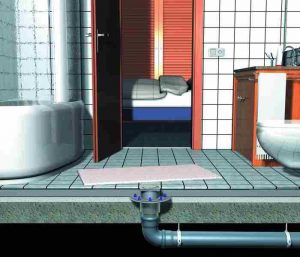
It has a small strainer that prevents foreign objects from entering the drain. This strainer also keeps unwanted pests from entering the house from the sewer. This strainer grate is usually a coarse one and sometimes small objects like hair, food, rocks and wood chips will get through the strainer and end up clogging the drain.
Just like any other drain in the house, floor drains can be unclogged with the right equipment and cleaning solution.
This article is focused on providing you a detailed description of all methods commonly used for unclogging a floor drain.
Note: If the process looks too complicated to do yourself, it is better to get professional help. There are a lot of local plumbers who can solve the problem within 24 hours at a reasonable price and causing minimum damage to your drain. Any damage that you create to the drain pipes will lead to serious problems, requiring extensive repairs and substantially delay unclogging your drain.
Identifying a Floor Drain Clog
The first step is to understand whether it is a clog in your floor drain or aother problem that led to standing water. We will talk about other causes for clogs later.
To start identifying the problem, remove the drain cover.
A typical all-in-one floor drain has two openings that lead to the same drain pipe. Both holes start in the drain area and lead to the same main drain pipe by different routes. You may also have a drain with separate drain and clean-out pipes. See below. If the drain is small like an interior bathroom floor drain, there will only be the main drain opening with no clean-out pipe.
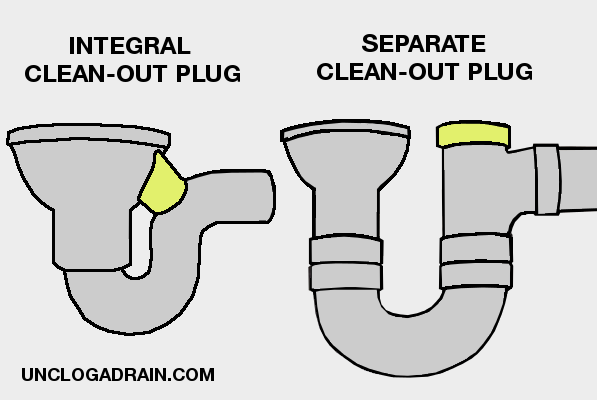
The main opening in the center is the opening to a larger diameter U- shaped pipe. The U-shape is designed as a trap to catch debris and collect water so gases from the sewer system can’t make their way back out of the drain.
The smaller clean-out tube on the site of the drain is a straight pipe with a clean out plug that is always closed. If there is a clog, the clean-out plug is designed to drain the stagnated water down the main drain pipe. Most clean-out plugs are made of plastic and are easy to remove. If the clean-out plug is metal you may need a pipe wrench, or hammer and cold chisel to remove it.
Remove the clean-out plug and wait for a few seconds. If the water drains immediately, it is definitely a clog in the “U” pipe part of the drain, due to some sort of stuck debris. Replace the clean-out plug — you just need to unclog the “U” pipe.
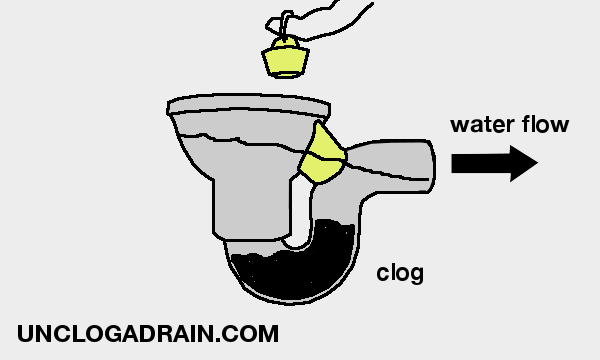
Note: If you somehow damaged the clean-out plug while pulling it out, you can easily replace it with a rubber expansion plug. These are found in almost all hardware stores. When replacing the clean-out plug, it’s better to stick with plastic or rubber plug to make it easier the next time.
If the water does not drain after removing the clean-out plug, then there is another problem which has led to a clog.
Important!
Leaving the clean-out plug open may sound like an easy solution if there is a clog in the “U” pipe. But this will cause BIG problems.
The main drain pipe is given a U-shaped tube for a reason. Due to the design of the tube, a small amount of water always remains at the bottom in that curve. This water stops noxious sewer gas from backing up in the drain pipe and entering your home or business. If you leave the clean-out plug open, you will allow sewer gas to flow unimpeded back through the drain. This can not only create a major odor and health problem, but the methane gas could potentially explode!
The clean-out tube is also smaller in diameter than the main drain pipe, and doesn’t have a U-shaped trap. This means your drain will back up quickly again, causing a second clog.
Thus, after locating the clog, always replace the clean-out plug.
What Causes Clogs in Floor Drains?
The main cause of clogged floor drains is debris. When grease or soap accumulates in the drain, it pulls other debris with it. Over time, it can become a big block in the pipe and stop the water from flowing down the drain.
However, this is not the only reason drains get clogged. Here are some other reasons:
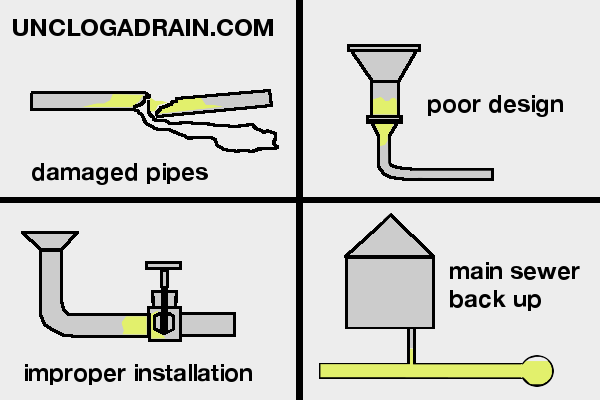
- Damaged or broken pipes – when the pipes are damaged due to wear and tear, cracks or unprofessional use of snakes or auger machines, clogs can happen.
- Inherently poor design – this happens when the volume of water is too large for the drain pipe diameter, or when there are too many sharp bends or joints in the pipe that slow and block the drain flow.
- Improperly installed pipes – joints that aren’t properly screwed or butted together, installing a valve the wrong way, etc.
- Main sewer system backups – sometimes, after a heavy rain, leaves and dirt get accumulated in the main sewer system, causing water to back up into neighborhood basements and drains.
On these occasions, the water will not drain properly, even after opening the clean-out plug. Even a small crack in the pipe or backup downstream will hinder the flow of water into a floor drain. This will naturally lead to water stoppage.
6 Methods to Unclog a Floor Drain
Now that you’ve determined that the clog is located in the U-shaped trap, what do you do? Here we go into detail on the six methods you can use to unclog a floor drain. You can try out simple methods first then progress to more complicated ones (or hire a professional).
1) Vinegar and Baking Soda Method
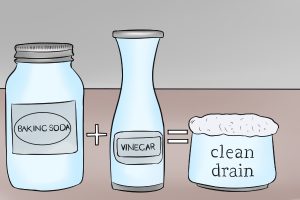 This is a very common solution for almost all kinds of clogs. Do you remember you chemistry classes? When an acid and a base are mixed together, it starts a neutralization reaction which lets out carbon dioxide and a lot of bubbles.
This is a very common solution for almost all kinds of clogs. Do you remember you chemistry classes? When an acid and a base are mixed together, it starts a neutralization reaction which lets out carbon dioxide and a lot of bubbles.
Vinegar is the acid here and baking soda is the base. Vinegar and baking soda can be used to dissolve a clog, thereby allowing flow of water through the floor drain.
For hygiene and to avoid smelling like vinegar, you want put some rubber gloves on beforehand.
First, using a screwdriver, remove the drain cover. Make sure to save the screws so that you can reinstall the drain cover later.
If the clog is right at the top scoop out the clog with your hand and dispose of it in the garbage.
If you can’t see the clog, pour some boiling water into the drain opening. This will soften any grease and soap.
Mix vinegar and soda in a bowl and pour it into the drain once it starts to create bubbles. After ten minutes add another pot of boiling water and close the drain cover.
This is also a preventive measure. If your floor drain gets clogged occasionally, you have to make sure that the clogs don’t accumulate too much. Every once in a while, add this vinegar and baking soda solution to the drain to remove any accumulated gunk, before it blocks the whole pipe.
Important tips for using this vinegar and baking soda method:
- Do not prepare the solution and store it. Once the neutralization process is done, the solution is no longer effective.
- Do not try this method after using any chemical drain cleaner. The chemical reactions could be dangerous!
Using vinegar and baking soda is the easiest and cheapest way to unclog a drain and there is no chance of damaging the pipes..
2) Plunger
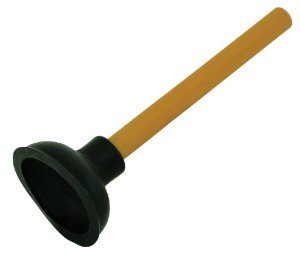 Using a plunger is a very straightforward method to unclog a floor drain. Since the clog cannot pass through the floor drain on its own, we are dislodging it and forcing it down the drain pipe by appying a pump-and-vacuum pressure.
Using a plunger is a very straightforward method to unclog a floor drain. Since the clog cannot pass through the floor drain on its own, we are dislodging it and forcing it down the drain pipe by appying a pump-and-vacuum pressure.
Place the plunger on the hole. If needed, apply petroleum jelly on the sides of the plunger to give it a better seal.
Now, depress the plunger with full force several times. Don’t worry. You won’t end up pulling the clog out on your floor — it will move down the drain only. If you get some clog material coming out of the drain, dispose of it.
After the clog moves and the water starts to drain, add a pot of hot / boiling water through the drain and replace the drain cap.
Tip: You can also use vinegar and baking soda after using a plunger.
If you do not have a plunger you can buy a good one here. It is a simple and cheap tool you ought to have in your home. There is no chance of damaging your drain or pipes with this method.
3) Drain Snake
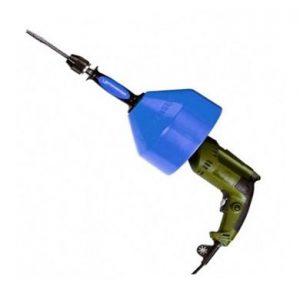
A plumber’s snake or drain snake is a long steel wire with a circular hook at the end for pulling out clogs in floor drains, traps and pipes. Snakes come in handheld manual form and electric or manually cranked “drum” snake form.
Insert the snake into the drain till you feel some resistance. The resistance will be felt when you reach the clog. If you feel a hard stop, it’s probably a joint or bend in the pipe. Do not force the snake — keep working it gently through the pipe until you reach the clot. Clogs will have some “give” to them.
Now, rotate the snake so the hook buries itself into the clog. Pull back. If you feel some resistance when you pull, you’ve got the clog. Pull it out of the drain and dispose of it.
Reinsert and repeat, pulling clog pieces out of the drain as many times as needed. Use some old towels or a plastic garbage bag to dispose of the clog material.
Add some boiling water after using the snake to clean out the rest of the drain pipe. In certain cases, you may also want to use a vinegar and baking soda solution after snaking your drain.
- Read in Detail: How To Use a Drain Snake?
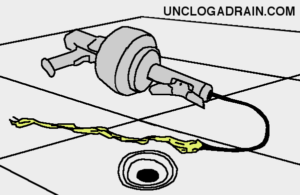
Important tips for using a drain snake to unclog your floor drain:
- Do not keep applying more pressure to the snake if you run into a hard stop. Instead, try to adjust the snake and gently work it around any bends or joints. Otherwise, you may break the pipe, which leads to bigger problems.
- Do not try to pull the snake out with force. If it won’t budge, turn the snake the other direction to release the clog and call a professional plumber. If you use too much force in either direction you may end up damaging the pipes and having an expensive repair on your hands.
- Be careful using a wire clothes hangar in lieu of a real plumber’s snake. Your hanger might get stuck inside the drain causing damage to the drain. A snake is not very expensive and you can get one quickly from any hardware store.
There are both mechanical drain snakes and electrical snakes available on the market. Make sure to read the instructions in detail before using it.
4) Chemical Drain Opener
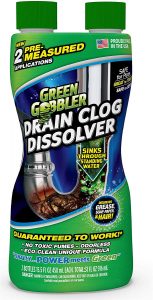 When a snake or plunger does not work, it means you’re dealing with a very thick clog, probably with a lot of grease and fat. You need something stronger to dissolve it and chemical drain openers can to the job.
When a snake or plunger does not work, it means you’re dealing with a very thick clog, probably with a lot of grease and fat. You need something stronger to dissolve it and chemical drain openers can to the job.
There are numerous quality chemical drain openers on the market under different brand names. They are all designed to dissolve clogs using powerful chemical reactions. Just follow the instructions on the bottle.
If you’re using a tablet form of drain opener, throw a couple tablets as instructed into the floor drain overnight. This will give plenty of time for the tablets to work and dissolve the clog.
Sometimes, a chemical drain opener would simply loosen the clog. You may need to use a snake or a plunger to remove it completely.
IMPORTANT: Do not add vinegar, baking soda or any other solution into the drain after using a chemical drain opener. Do not mix two brands of chemical drain opener. These mistakes may cause dangerous chemical reactions.
After the drain opener solution has done its work and the drain is clear, we suggest flush the drain out with lots of warm water. This ensures you don’t get noxious chemical fumes or splashes coming back from the drain.
- Check out our Best Liquid Drain Cleaner Reviews
Important tips for using the chemical drain opener method:
- Do not mix it with vinegar and baking soda. There should be at least an hour gap between the two solutions.
- Do not use a wet vacuum after pouring chemical drain opener down your drain. The vacuum will pull chemicals and fumes out and potentially burn your skin, eyes and lungs. You can use a snake or plunger after using this solution.
- The solution is harmful when ingested. Do not keep it anywhere where the kids or pets could get hold of it.
5) Bio Drain Solution
These are bacteria based drain solutions. This method is commonly used by people who are environment friendly and people who do not want to have harmful chemicals in their home.
After adding the bio drain solution into the floor drain, wait for as long as the directions indicate. The bacteria will ingest all organic items and clear the clog. The bacteria will easily dissolve organic waste debris in the clog. Bacteria can take longer than chemical solutions, but the effect is generally comparable.
After pouring the bio solution down the drain do not immediately use boiling water. This will kill the bacteria. Using any other chemical solutions along with this type of drain opener would also kill the bacteria.
Bio drain solutions will not dissolve rust, plastic or other non-organic debris in the clog. You will need to use a mechanical method such as a plunger, snake or auger. Or you can use a stronger chemical drain opener solution.
The upside of bio drain solutions is that bacteria will not damage your plumbing and it is very safe to use.
6) Wet Vacuum
You can rent or buy a wet vacuum to unclog a floor drain. This is a very efficient method that works for pulling the majority of clogs out of U-pipe traps.
You can either start sucking the clog out with your wet vacuum after removing the drain cover, or use another mechanical method first like a snake or auger.
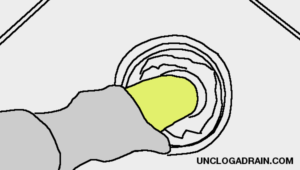
IMPORTANT! You should never use the wet vacuum method to unclog a floor drain after you’ve already used a chemical or bio drain operner solution. The vacuum will pull chemicals and fumes back into the room, potentially burning your skin, eyes and lungs.
Try to remove any loose debris, as much as possible from the drain. Insert the hose of the vacuum and switch on the suction. You should feel the clog move through the vacuum hose. When this happens the high-pitched vacuum sound will get lower as it pulls the clog out.
Once you think you’ve gotten all of the clog, remove the hose.
Now, pour a pot of boiling water down the drain to clear out the rest of the clog.
Once you’re done, empty the dirty drain water and clog material out into a large sewer drain. Clean up the area with towels and disinfectant.
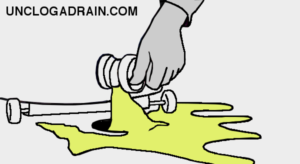
In some cases, the clog will be very strong or too deep down the pipe and your wet vacuum won’t work. We advise switching to a plumbing auger or snake for these difficult situations.
Important tips for using the wet vacuum method:
- Do not use chemical solutions along with the wet vacuum.
- Do not wear loose clothing while operating.
- Learn to use the machine’s controls before operating it.
- Wear ear protection because wet vacuums are very loud.
Using Professional Drain Cleaning Machines
In simple terms, these are upgraded versions of your basic plumber’s snake or wet/dry vacuum. They are very costly to buy but there are numerous places where you can rent one. Before you rent a machine, you should learn the clog’s location and the size of your drain hole.
If you rent a professional plumber’s snake, you need to get one with the right cable size. A drain hole of 1 ½ inch to 3-inch diameter would need a cable of ½ inch diameter. A larger floor drain would need a ¾ inch cable. Using a larger cable for a small hole will damage your pipes.
Positioning the drain cleaning machine and practicing beforehand is important. Try inserting the cable into the drain and to figure out the best position. Place the foot switch near you. Switch on the machine and try controlling it with the foot switch. Once you are versed with these controls, turn the machine on and advance slowly to avoid damaging your drain pipes.
If you are not comfortable in using one of these powerful machines, there is no harm in getting help from a professional plumber!
These are the available methods to unclog a floor drain.